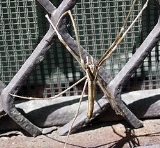
Deinopidae
Encyclopedia
The spider
family Deinopidae consists of stick-like elongate spiders that build unusual webs that they suspend between the front legs. When prey approaches, the spider will stretch the net to two or three times its relaxed size and propel itself onto the prey, entangling it in the web. Because of this, they are also called net-casting spiders.
Their excellent night-vision adapted anterior median eyes allow them to cast this net over potential prey items. These eyes are so large in comparison to the other six eyes that the spider seems to have only two eyes.
The genus
Deinopis
is the best known in this family. Spiders in this genus are also called ogre-faced spiders, due to the similarity between their appearance and that of the mythological creature, the ogre
. It is distributed nearly worldwide in the tropics, from Australia
to Africa
and the Americas
. In Florida
, Deinopis often hangs upside-down from a silk
line under palmetto
fronds during the day. It emerges at night to practice its unusual prey capture method.
The genus Menneus is also known as "humped-back spider", and Avellopsis as "camel-backed spider".
The entire family is cribellate.
Spider
Spiders are air-breathing arthropods that have eight legs, and chelicerae with fangs that inject venom. They are the largest order of arachnids and rank seventh in total species diversity among all other groups of organisms...
family Deinopidae consists of stick-like elongate spiders that build unusual webs that they suspend between the front legs. When prey approaches, the spider will stretch the net to two or three times its relaxed size and propel itself onto the prey, entangling it in the web. Because of this, they are also called net-casting spiders.
Their excellent night-vision adapted anterior median eyes allow them to cast this net over potential prey items. These eyes are so large in comparison to the other six eyes that the spider seems to have only two eyes.
The genus
Genus
In biology, a genus is a low-level taxonomic rank used in the biological classification of living and fossil organisms, which is an example of definition by genus and differentia...
Deinopis
Deinopis
Deinopis is a genus of net-casting spiders.-Name:The genus name is derived from the Greek deinos "fearful" and opis "appearance"; see also the family name "ogre-faced" spiders.-Species:...
is the best known in this family. Spiders in this genus are also called ogre-faced spiders, due to the similarity between their appearance and that of the mythological creature, the ogre
Ogre
An ogre is a large, cruel, monstrous, and hideous humanoid monster, featured in mythology, folklore, and fiction. Ogres are often depicted in fairy tales and folklore as feeding on human beings, and have appeared in many classic works of literature...
. It is distributed nearly worldwide in the tropics, from Australia
Australia
Australia , officially the Commonwealth of Australia, is a country in the Southern Hemisphere comprising the mainland of the Australian continent, the island of Tasmania, and numerous smaller islands in the Indian and Pacific Oceans. It is the world's sixth-largest country by total area...
to Africa
Africa
Africa is the world's second largest and second most populous continent, after Asia. At about 30.2 million km² including adjacent islands, it covers 6% of the Earth's total surface area and 20.4% of the total land area...
and the Americas
Americas
The Americas, or America , are lands in the Western hemisphere, also known as the New World. In English, the plural form the Americas is often used to refer to the landmasses of North America and South America with their associated islands and regions, while the singular form America is primarily...
. In Florida
Florida
Florida is a state in the southeastern United States, located on the nation's Atlantic and Gulf coasts. It is bordered to the west by the Gulf of Mexico, to the north by Alabama and Georgia and to the east by the Atlantic Ocean. With a population of 18,801,310 as measured by the 2010 census, it...
, Deinopis often hangs upside-down from a silk
Spider silk
Spider silk is a protein fiber spun by spiders. Spiders use their silk to make webs or other structures, which function as nets to catch other animals, or as nests or cocoons for protection for their offspring...
line under palmetto
Sabal
Sabal is a genus of New World palms, many of the species being known as palmetto. They are fan palms , with the leaves with a bare petiole terminating in a rounded fan of numerous leaflets; in some of the species, the leaflets are joined for up to half of their length...
fronds during the day. It emerges at night to practice its unusual prey capture method.
The genus Menneus is also known as "humped-back spider", and Avellopsis as "camel-backed spider".
The entire family is cribellate.
Genera
- Avella O. P-CambridgeOctavius Pickard-CambridgeThe Reverend Octavius Pickard-Cambridge FRS was an English clergyman and zoologist.Pickard-Cambridge was born in Bloxworth rectory, Dorset, the fifth son of Revd George Pickard, rector and squire of Bloxworth: the family changed their name to Pickard-Cambridge in 1848...
, 1877 (Australia) - Avellopsis PurcellWilliam Frederick PurcellWilliam Frederick Purcell was a South African arachnologist and biologist.-External links:...
, 1904 (South Africa) - DeinopisDeinopisDeinopis is a genus of net-casting spiders.-Name:The genus name is derived from the Greek deinos "fearful" and opis "appearance"; see also the family name "ogre-faced" spiders.-Species:...
MacleayAlexander MacleayHon. Alexander Macleay MLC FLS FRS was a leading member of the Linnean Society and a fellow of the Royal Society.Macleay was born on Ross-shire, Scotland, eldest son of William Macleay, provost of Wick...
, 1839 (on every continent, except Europe and Antarctica) - Menneus SimonEugène SimonEugène Simon was a French arachnologist. His many taxonomic contributions include categorizing and naming many spiders, as well as creating genera such as Anelosimus, Psellocoptus and Phlogius....
, 1876 (Africa)
External links
- Info on Deinopidae (with pictures)

